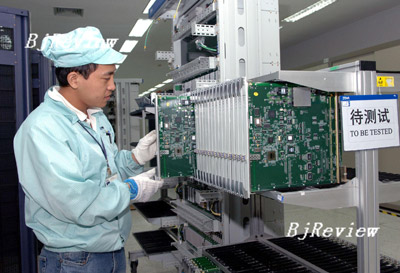
On February 27, at the annual national sci-tech awards ceremony attended by Chinese President Hu Jintao and Premier Wen Jiabao, scientists and enterprises that made remarkable progress in technological innovation over the past year were presented with the nation's top science honors.
On the list of awardees was Dr. Wu Ping, CEO of Shanghai-based mobile phone chip developer Spreadtrum Communications Inc., which developed world's first TD-SCDMA baseband chip and Asia's first 2.5G (GSM/GPRS) baseband chip.
The appearance of Spreadtrum, a start-up firm led by technicians returning to China from Silicon Valley in the United States, turned public attention to innovation in the private sector, often regarded as a technology backwater in China. According to official statistics, in 2006 private companies participated in more than 20 percent of projects that won National Prizes for Progress in Science and Technology, a substantial increase from the previous year.
"This shows that the country has provided a relaxed environment for the private sector and more and more private companies have started to focus on long-term development," said Professor Chen Naixing, Director of the Research Center For Small and Medium-Sized Enterprise under the Chinese Academy of Social Sciences. He predicted that the trend for an increasing number of private companies winning national science and technological awards would continue.
According to officials in charge of the awards, China's small and medium-sized private technology companies have managed to build a sound business model for innovation and have gradually grown into an important force for technological innovation. Huang Mengfu, Chairman of All-China Federation of Industry and Commerce (ACFIC), an organization representing entrepreneurs from the private sector, said innovation capacity represents a challenge not only to private companies but also to the Chinese Government. The government has set a goal of building an innovation-oriented country by 2020.
According to Huang, the major force for realizing this goal is the corporate sector. While in the short and middle terms, state-owned enterprises and research institutions will remain main sources of innovation in China's science and technology sector, in the longer-run the private sector will grow in strength and begin to take the lead, he said.
Rising economic power
According to statistics from the All-China Society of Private Economy Research, the number of private companies in China reached 4.64 million by June 30, 2006. Statistics from the ACFIC show that by the end of 2005 the private sector owned by mainland entrepreneurs had created roughly half of China's gross domestic product (GDP). And an ACFIC report forecast that the private sector will account for three quarters of China's GDP by 2010 and more than 70 percent of companies in China will be privately owned.

The development of China's private sector is still at a nascent stage, which explains why only a small percentage of privately owned companies are involved in scientific innovation or own patented technologies. Among more than 90,000 private companies in Chongqing Municipality, less than 2 percent own proprietary technology.
However, with the soaring development of China's economy and intensified competition in the international market, a growing number of Chinese entrepreneurs are beginning to understand the value and urgency of innovation. Against this backdrop, there has been a surge in registrations of private technology companies. Meanwhile, more established firms have transformed themselves by working out long-term innovation goals.
According to statistics from a science and technology entrepreneurs association, by the end of 2005 China's private technology companies numbered 150,000, a 70-percent increase over 2000, offering a quadrupling in tax revenues.
November 27, 2006 witnessed the opening of the first exhibition on innovation by privately owned Beijing companies, where 40 private firms from the city showcased their achievements on the Internet. The purpose of the exhibition was to encourage more private companies to be innovative.
Beijing Jianli Pharmaceutical Co. was one of the exhibitors at the event. The pharmacy company, founded in 1992, has been following a hi-tech innovation path since 2004. Now the company holds a strong market position and has developed new proprietary products.
"Since private companies don't have competitive edges in other fields, enhancing innovation capacity while adjusting to market demand is an essential strategy for their sustainable development," Han Zhe, an assistant to the general manager of Jianli Pharmaceutical Co., told Beijing Review. He said his company's strategic transformation to become a hi-tech firm is necessary to promote its growth.
According to surveys conducted by the ACFIC, in Suzhou, a vibrant new industrial base 80 km west of Shanghai, 70 percent of private technology companies have built their own research and development centers and 60 percent of core technologies of private technology companies in the area are self-developed.
Private technology firms occupy an even more solid position in Shenzhen, the southern economic hub neighboring Hong Kong. Among more than 1,700 hi-tech companies in the city, about 70 percent are privately owned while 76 percent of the city's scientific inventions are created by private companies.
The private sector is rapidly becoming the most dynamic and promising sector for innovation in China. According to statistics from the ACFIC, more than 70 percent of companies in the country's 53 national hi-tech industrial parks are privately owned. Other statistics from the Ministry of Technology show that since China adopted policies of reform and opening up in 1978, about 70 percent of technological innovation, 65 percent of patents applications and 80 percent of new product development have come from small and medium-sized firms. More than 95 percent of small and medium-sized companies are privately owned.
The innovation boom at private technology companies has much to do with the macroeconomic environment. Private companies cannot get financing or technological support from the government, so are forced to innovate in order to survive. They generally aim for low cost, high efficiency innovations based on promising market prospects. Their hunger to survive in the free market has given them an edge over state-owned enterprises.
Shenzhen-based Huawei Technologies, a telecommunications equipment supplier, is a Chinese success story. By developing technologies to suit market demand the firm has jumped from being a small company with capital of just 20,000 yuan to become a multinational giant in telecom hardware and software with 40,000 employees, more than 6,000 patents and 60 billion yuan sales revenue. Huawei is now China's biggest private technology company.
Unfair treatment
ACFIC polls indicate that although private companies are increasingly aware of the importance of innovation, translating desire into action has been inhibited by an acute shortage of human resources, technology and capital.
According to the results of the national economic census, the proportion of employees at private firms educated to the level of a junior college diploma or above is 14 percent, well below the national average of 24 percent and the state owned enterprise level, which is 46 percent. Even in the economically advanced eastern region of China more than 70 percent of private companies complain about a lack of technicians.

This lack of highly educated staff is rooted in the private sector's long-time marginalized status in China's economy, which has made it difficult to attract talent. Furthermore, it is not until recently that the country's social security system was extended to cover the employees of private firms. The lack of security associated with private firms had scared many qualified staff away from them.
Lack of capital for research and development has been another major barrier for private technology companies. According to polls by the Shanghai Federation of Industry and Commerce, lacking research and development capital plagues 80 percent of private companies in Shanghai. Further 62 percent of companies claim that internal company investment is their sole source of research and development capital.
The government's budget for supporting science and technology is given mainly to universities and research institutions, with only a small proportion trickling down to companies. And of the small number of companies that receive any financing, the vast majority are state-owned.
In 2005, China's total government subsidy for scientific research amounted to 133.5 billion yuan, of which less than 10 million, or less than 10 percent, was given to private companies. Considering the huge number of private companies this represented a tiny amount of financing.
Private technology companies have also faced enormous difficulty in raising money from other channels. According to the National Bureau of Statistics, short-term loans for private companies totaled 218.1 billion yuan in 2005, which accounted for only 2.5 percent of all such loans issued that year. The proportion was extremely small considering private companies' contributions to innovation and their urgent demands for funding. Surveys show that in China's Silicon Valley, Zhongguancun, companies have a total unsatisfied investment gap of over 40 billion yuan, averaging 2.8 million yuan for every company. And the absolute majority of companies in Zhongguancun are privately owned.
When most private technology companies begin, all that the entrepreneurs launching them have are the invisible assets of patented technologies and their innovation capacity. Even if these companies do have lucrative business projects, it is difficult for them to get loans, because they do not have real property to offer as security.
Beijing-based Jianli Pharmaceutical Co. is an established bio-pharmacy company. Its size and resources have made getting financing easier, but according to Han Zhe from the firm, the "unfavorable macro environment" still makes getting financing "fairly difficult."
Privately owned Chinese firms also face unequal treatment with regard to taxation, paying higher levels of value-added tax and personal income tax than state-owned enterprises or overseas companies. Their inferior status in both financing and taxation has dampened the private sectors' enthusiasm and capability to innovate.
Platform for fair competition
For the time being, the greatest barrier to technological innovation by private companies is shortage of money. Professor Chen believes the government has a responsibility to lean more toward private technology companies in distributing government funding for innovation and to broaden the financing channels for private firms.
A study conducted by the ACFIC contained suggestions for promoting development of the private sector. It suggested that banks should consider the difficulty private technology companies face in providing loan security and allow invisible assets such as intellectual property to be used as security. Meanwhile, the Chinese Government should learn from the experience of Western countries by forming a professional bank to serve only technology companies, according to the study. The bank, which would be based in a technology region, would accept deposits from local residents and loan money to research institutions and technology firms, focusing special attention on start-ups.
Professor Chen believes a key measure for promoting innovation among private companies is to give them equal treatment with state-owned enterprises.
"Banks should calculate the economic feasibility of a loan based on the prospects of the project rather than the nature of the company," he said.
The ACFIC study also suggested that the government could assist private firms by providing a means for them to connect with research institutions and investors, while backing them with the necessary resources.
"Private companies are at a stage of rapid development and the government's practical support and encouragement will enable them to contribute more to the strategy of an innovation-oriented country, " he said.
| 